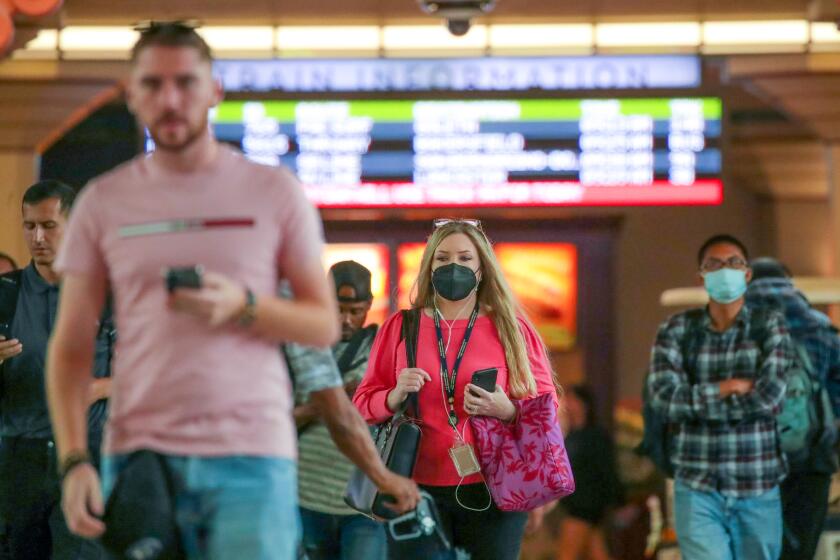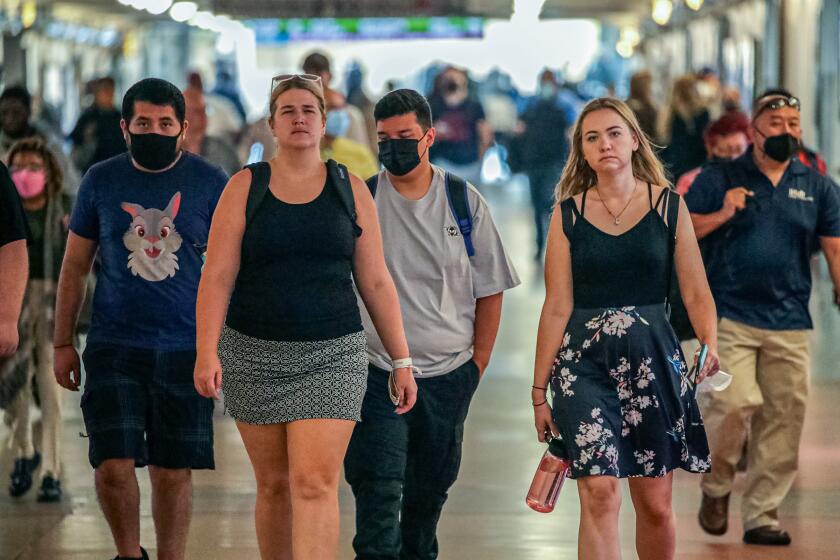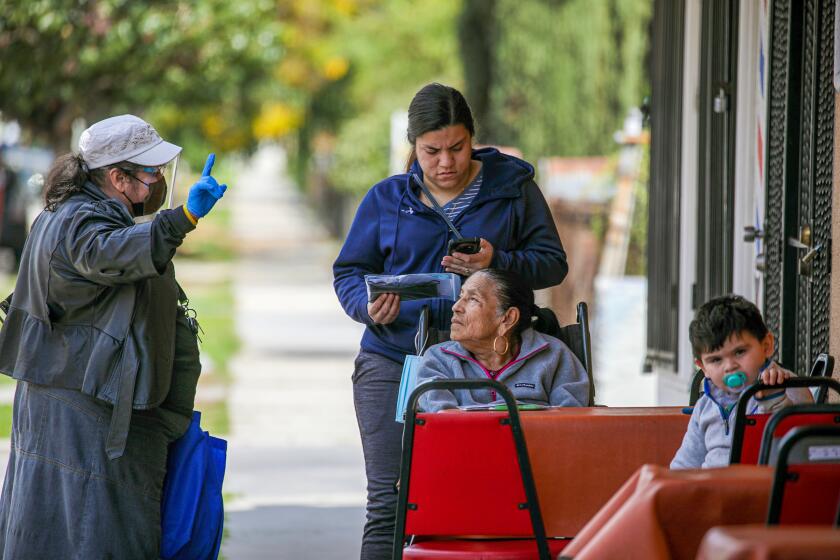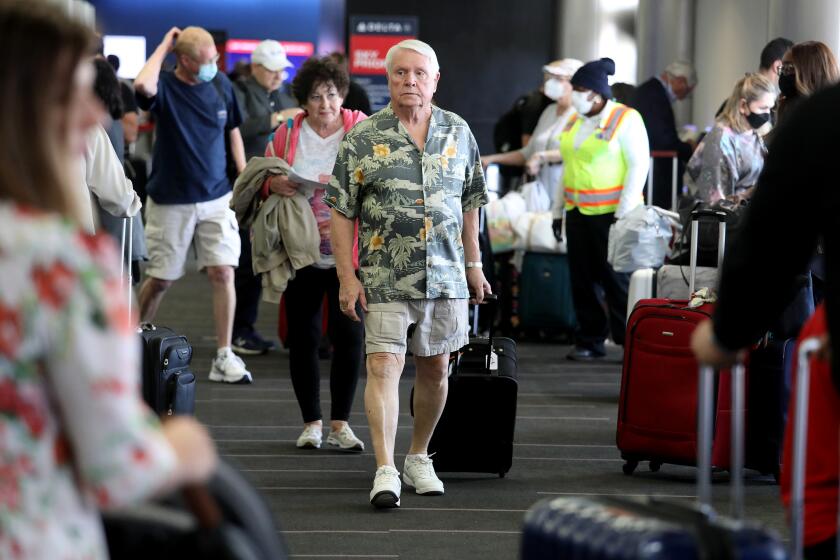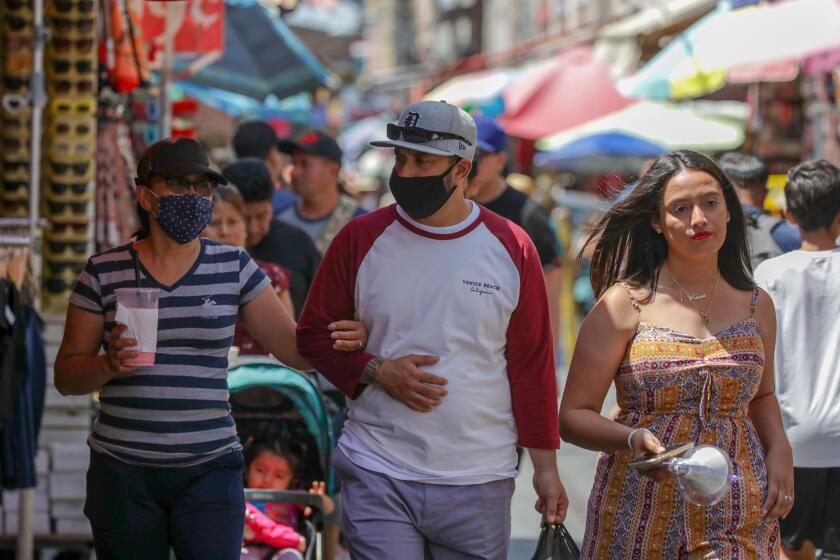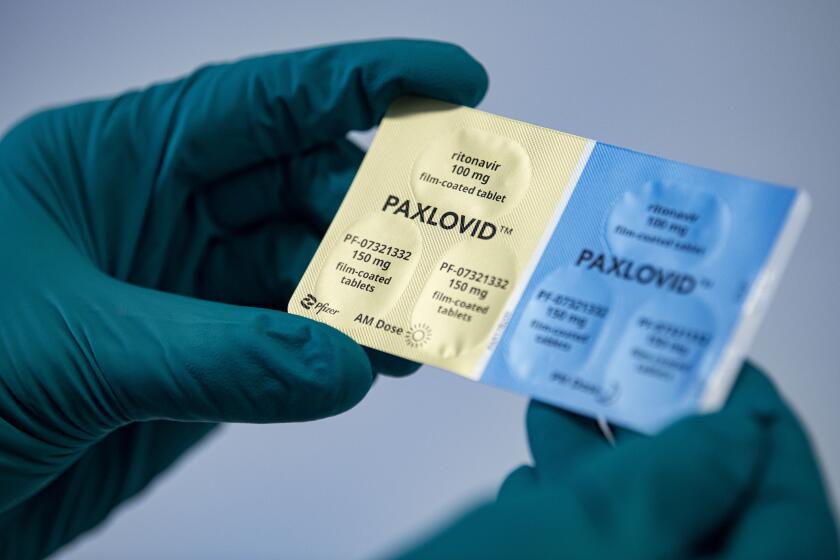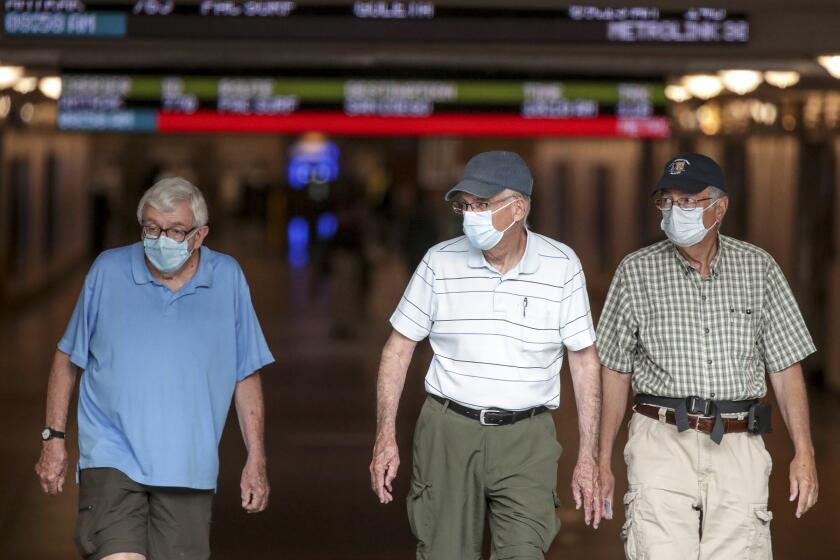L.A. is headed for a new COVID mask mandate. Will other counties join?
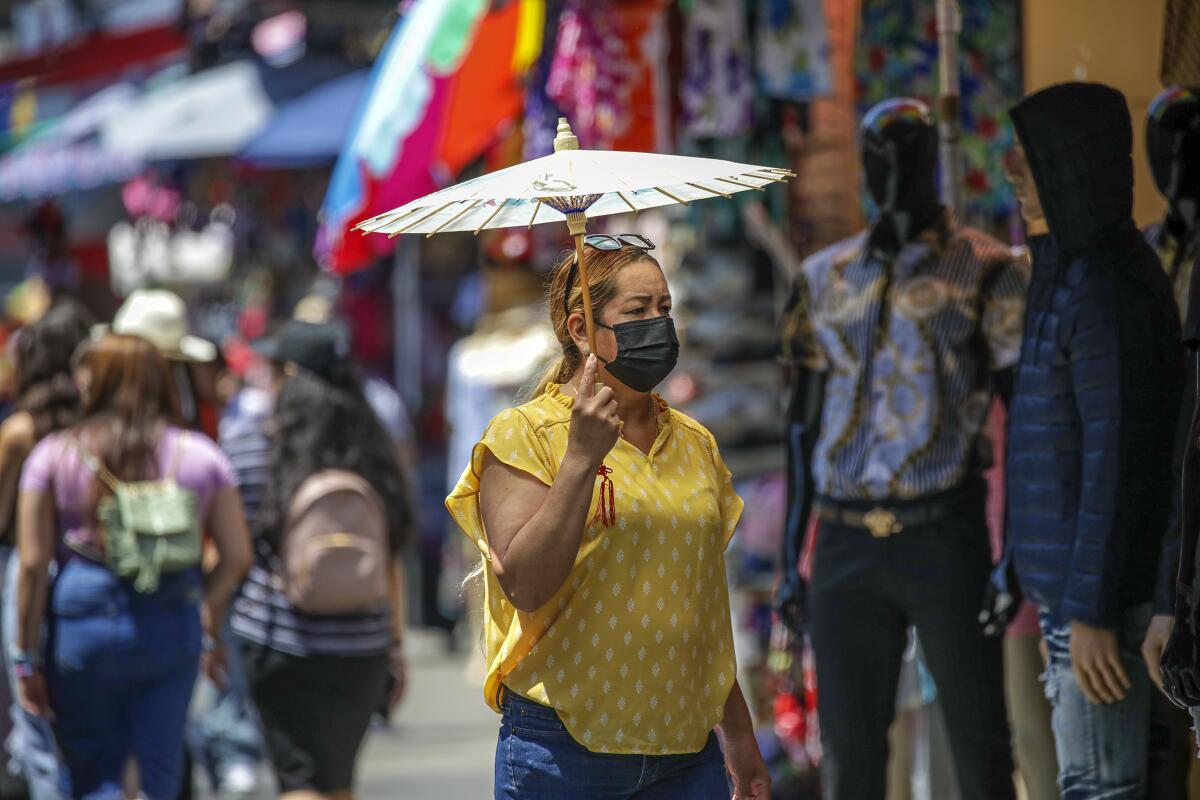
- Share via
With the coronavirus resurgent and cases and hospitalizations on the rise, Los Angeles is poised to become the first Southern California county to reinstate mandatory public indoor masking.
If the situation sounds familiar, it’s because it is. Almost exactly one year ago, the county took the same step to combat a surge fueled by the Delta variant of the coronavirus. It was the first, but it wasn’t the last. Officials in at least 20 counties — including Ventura, Santa Barbara, Santa Cruz, Sacramento and a large swath of the San Francisco Bay Area — would eventually follow suit.
Unless conditions improve, Los Angeles County will by the end of the month find itself in an identical position: issuing a face covering order even though no other county currently appears ready to do the same.
But as California grapples with another summertime wave — this one driven by the highly infectious family of Omicron subvariants, namely BA.5 — will L.A. County prove to be ahead of the curve or, as some critics maintain, behind the times?
If the county remains at the high community level for the next two weeks, a new masking order would be issued, with an effective date of July 29.
What would trigger the mask order?
The U.S. Centers for Disease Control and Prevention recommends universal indoor public masking for those 2 and older when a county enters the high COVID-19 community level — a designation signifying both that coronavirus transmission is elevated and that the spread is starting to affect hospitals.
L.A. County officially entered the high community level Thursday. Should it remain there for the next two weeks, the county will reissue an indoor mask mandate with an effective date of July 29.
No other California county has publicly tied its placement on the CDC’s community level scale to a renewal of masking orders. Along with L.A., 41 other counties are in the high level as of this week.
Most places recommend, but do not require, masking indoors while in public.
“We are seeing a summer wave in cases and hospitalizations, and this move to the ‘high’ transmission level confirms that,” Dr. Clayton Chau, director of the OC Health Care Agency, said in a statement. “To protect those at high risk, we are recommending that OC residents continue masking in public, indoor settings, especially those who are at high risk or living with loved ones who have comorbidities, are immunocompromised or are prone to getting sick.”
Alameda County was the first California county to issue a mandatory indoor masking order following the winter Omicron surge. Issued on June 3, it was rescinded three weeks later on June 25.
Weekly COVID-19 deaths doubled in Los Angeles County over the last month, to 100 from 50 a week.
Why is a mask mandate being considered?
L.A. is like no other county in the United States. With some 10 million residents, it is far and away the most populous county in the nation — home to more residents than most states.
Overcrowded housing, a risk factor for the spread of the coronavirus, is worse in L.A. County than many other parts of the country, including the Bay Area.
Of all of Southern California’s coastal counties, L.A. has the highest rate of poverty and lowest median household income. People living in lower income areas are more likely to be hospitalized or die from COVID-19 than those living in wealthier areas — even when vaccination status is the same.
Lower-income people in L.A. County power substantial sectors of the local economy, including food production, hospitality and tourism.
Wealth, poverty and race dramatically affect the toll of the coronavirus, with Latinos and Black communities in the county continuing to be hit hard.
All this means that, when a new wave hits, a place like L.A. County may be hit disproportionately harder than neighboring places.
“Families with fewer resources are more likely to have more exposures at work, live in crowded conditions and have one or more chronic health conditions compared to those with more resources,” county Public Health Director Barbara Ferrer said during a briefing Thursday. “This places individuals at higher risk of suffering the severe effects from COVID. Since vaccination alone is not sufficient to erase the troubling inequities we see, additional efforts are needed to protect those at greatest risk.”
Would masks help?
Masking has been the subject of heated debate and at times fervent opposition throughout the pandemic. But officials and experts are largely in agreement that wearing a high-quality, well-fitting face covering provides additional protection — especially in indoor or crowded spaces.
“There is broad consensus in the scientific community that wearing a high-quality mask in indoor public spaces is an important tool to control the spread of COVID-19. [It] prevents you from getting infected, and it prevents you from spreading it to others,” Dr. Ashish Jha, the White House COVID-19 response coordinator, said during a recent briefing.
Many experts stress that face coverings still protect against the coronavirus and that masking up makes sense — even if it’s no longer mandatory.
Masking, Ferrer said, “protects all of us.”
“When people who are infected wear a mask, they exhale far less virus into the air than infected people who do not mask,” she said. “Masks also provide protection to the individual that’s wearing a mask by filtering virus from the air as they’re breathing. When everyone in the room is masked, safety is enhanced as there’s less virus circulating and less likelihood that any virus that is circulating will penetrate the physical barrier.”
Public health
Ferrer said the rationale for a mask order during a time of high hospitalization rates is similar to the sensible collective actions taken to reduce other public safety risks, such as rules limiting drivers’ alcohol consumption and requiring seat belts.
“The reality is that because we’re living with a mutating SARS-CoV-2 virus, there remains uncertainty around the trajectory of this pandemic,” Ferrer said. “We should not settle for the existing high rates of morbidity and mortality that disproportionately affect those most vulnerable.”
Although it’s true that the versions of the coronavirus currently in circulation tend to cause less severe symptoms, they’re not harmless. As Ferrer noted, “You cannot predict with any degree of certainty whether, if you get infected, you’re going to be one of the luckier ones that ends up with mild illness or one of those that ends up with severe illness.”
And just as no one can guarantee they won’t suffer long-term risk, they also can’t predict the potential health effects should they spread the virus to others — especially those at higher risk.
“I think we kind of owe it to each other to do whatever we can to reduce that burden, and to really acknowledge that it has disproportionately affected people who are either older, have serious underlying health conditions, or have more exposures, which tends to be people who … are our essential workers,” Ferrer said.
L.A. County is already experiencing a surge from the Omicron subvariant BA.5, but another strain causing concern in India has also been found locally.
Healthcare effects
As of Thursday, L.A. County hospitals were caring for 1,223 coronavirus-positive patients — double the number recorded a month ago.
Hospital inpatient units are not reporting being overwhelmed, and the overall patient count remains well shy of the figures reported during the pandemic’s earlier waves. But other facilities, including emergency departments, urgent care centers and community clinics “are telling us that they’re feeling very strapped,” Ferrer said.
“They have staffing shortages because lots of their staff are sick with COVID and out, and they also have lots of their patients that — while they don’t need to go to the hospital — they do need medical care, and that creates some stress as well.”
Vaccinations and anti-COVID drugs have made it less likely that large numbers of patients will need intensive care during this surge, Ferrer said. But, she added, “we also have a lot of unknown with BA.5, and anything else that comes our way. What’s going on in our hospitals could change.”
The latest maps and charts on the spread of COVID-19 in Los Angeles County, including cases, deaths, closures and restrictions.
“Waiting until hospitals are overwhelmed is way too late to try to do much about slowing transmission,” she said. “The time to slow transmission is actually when you start seeing indicators that you’re having more utilization at your hospitals.”
Weekly COVID-19 deaths in L.A. County have doubled in the last month, with officials reporting 100 deaths a week. The weekly peak during the initial Omicron surge last fall and winter was more than 500.
There are two antiviral pills available for eligible patients who have recently tested positive for the coronavirus. And they’re free.
What type of mask should I wear?
The most effective masks are N95, KN95 and KF94 respirators. You should not double-mask with a respirator.
Another type, though with a lower degree of effectiveness, is a surgical mask, also known as medical masks, which are looser fitting and sometimes called blue masks for their tinted color. They can be made more effective by placing a cloth mask over the surgical mask.
“This helps hold the edges of the medical mask to your face and creates a better seal,” Ferrer said.
When higher-quality masks were in short supply, cloth masks with at least three layers were seen as a better option than thinner cloth masks. But it’s now clear that even three-layer cloth masks provide minimal protection, according to Ferrer. Bandannas, gators and thin cloth masks are not effective at filtering out the virus.
The subvariant BA.5 made up 65% of U.S. coronavirus cases over the week ending Saturday. A month ago, it made up 17% of cases.
“While [cloth masks are] better than wearing no mask, given that we have a highly transmissible set of variants circulating, upgrading your mask makes a big difference in the level of protection,” Ferrer said.
Masks should be worn over both the nose and mouth, and disposable masks and respirators should be thrown away when they become wet or dirty.
“For people who cannot wear a mask due to a disability or medical condition, face shields with drapes that go under the chin and are attached at the bottom edge can provide additional protection,” Ferrer said.
More to Read
Sign up for Essential California
The most important California stories and recommendations in your inbox every morning.
You may occasionally receive promotional content from the Los Angeles Times.
